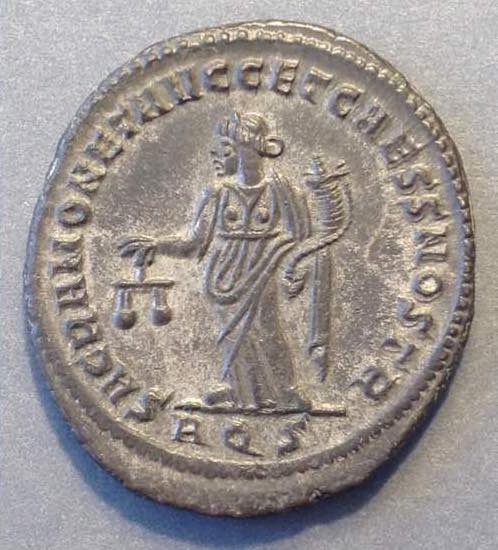 SACRA MONETA: A common late Roman coin type
SACRA MONETA: A common late Roman coin type
For an overview of Roman coins of the First Tetrarchy, begin here. This page is a detailed look at one common type issued c. 300-305.
The follis (a.k.a. nummus) denomination was introduced c. 294 during the First Tetrarchy ("four rulers"). Diocletian and Maximian were the Augusti and Galerius and Constantius were the Caesars. The initial and most common type had legend GENIO POPVLI ROMANI with the Genius of the Roman people standing left holding a patera and cornucopia (with its own pages here). The second-most-common type of follis is the subject of this page.
The design is constant: Moneta standing left, holding balance and cornucopia. It was issued at five mints with several similar legends that are variants of
SACRA MONET AVGG ET CAESS NOSTR (illustrated to the right, from the mint of Aquileia)
"Sacred coinage of our Augusti and Caesars".
What's new? 2025, Feb. 22: Maximian from Siscia.
2022, Sept. 20: Constantius from Siscia.
2021, April 23: Galerius from Rome.
2021, Feb. 5: Diocletian from Siscia.
There are numerous legend varieties, including:
SACRA MONET AVGG ET CAESS NOSTR, common from Aquileia, Ticinum, and Siscia.
SACRA MON VRB AVGG ET CAESS NN, also abbreviated "SAC MON VRB..." and "S M VRB ..." from Rome,
MONETA SACRA AVGG ET CAESS NOSTR (with the first two words reversed) and M SACRA ... and MONETA S ... and MONETA S AVGG ET CAESS NN from Trier, and
MONETA AVGG ET CAESS NN (omitting SACRA) from Siscia
This type was issued in the names of all four tetrarchs. The essential reference is RIC (Roman Imperial Coinage) volume VI, by C. H. V. Sutherland. It is old (1973) and many varieties "not in RIC" have been found since then, but there is no easy way to learn more about the coinage of this time period.
• all have laureate head right unless otherwise described (The exceptions are from Trier.).
• variants of the legend SACRA MONET AVGG ET CAESS NOSTR with have the difference emphasized in bold.
Coins are organized by mint. Go down to coins of Aquileia, Ticinum, Siscia, Rome, and Trier.
Aquileia. Examples are most common from Aquileia and Ticinum. Many pieces from Aquileia are in excellent condition. Some have large round heads (the third one down) and others smaller heads.
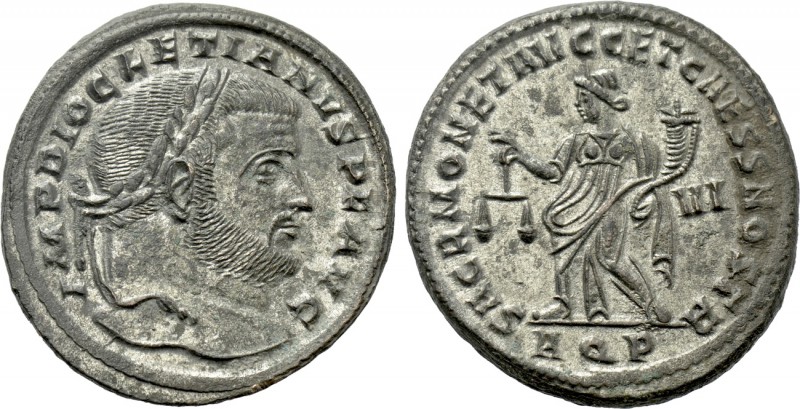 Diocletian
Diocletian
27 mm. 10.04 grams.
IMP C DIOCLETIANVS PF AVG
SACR MONET AVGG ET CAESS NOSTR
VI
AQP
RIC Aquileia 35a "c. 302-303"
Sear IV 12820.
 Diocletian
Diocletian
27-25 mm. 9.22 grams.
IMP C DIOCLETIANVS PF AVG
SACRA MONET AVGG ET CAESS NOSTR
AQP
RIC Aquileia 29a "c. 300"
This head is smaller and with a longer neck than the head on the previous coin. The next coin, of Maximian, has an even larger head.
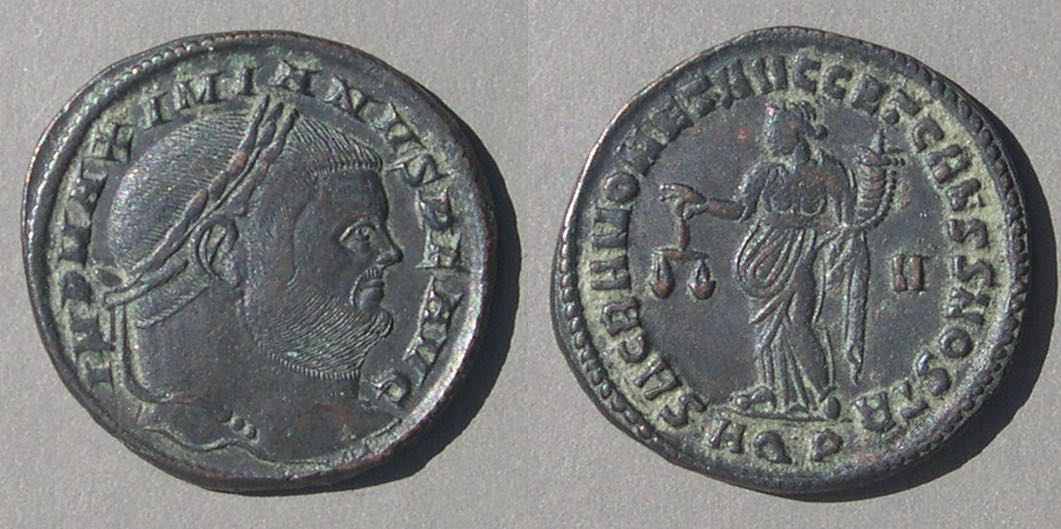
Maximian
27 mm. 9.82 grams.
IMP C MAXIMIANVS PF AVG
SACRA MONET AVGG ET CAESS NOSTR
V
AQP
RIC Aquileia 31b "c. 301"
Sear IV 13300.
Some coins of Aquileia have this style--a massive head with a relatively small face.
 Another Maximian
Another Maximian
28-26 mm. 9.91 grams.
IMP MAXIMIANVS PF AVG
SACRA MONET AVGG ET CAESS NOSTR
AQS
RIC Aquileia 29b "c. 300"
 Galerius
26 mm. 9.24 grams.
Galerius
26 mm. 9.24 grams.
MAXIMIANVS NOB CAES
SACRA MONET AVGG ET CAESS NOSTR
V
AQΓ
RIC Aquileia 32b "c. 301"
Sear IV 14405
 Constantius
Constantius
28-25 mm. 9.82 grams.
CONSTANTIVS NOB CAES
SACRA MONET AVGG ET CAESS NOSTR
V
AQΓ
RIC Aquileia 32a "c. 301"
Sear IV 14094
Ticinum. Many examples from Ticinum are in excellent condition.
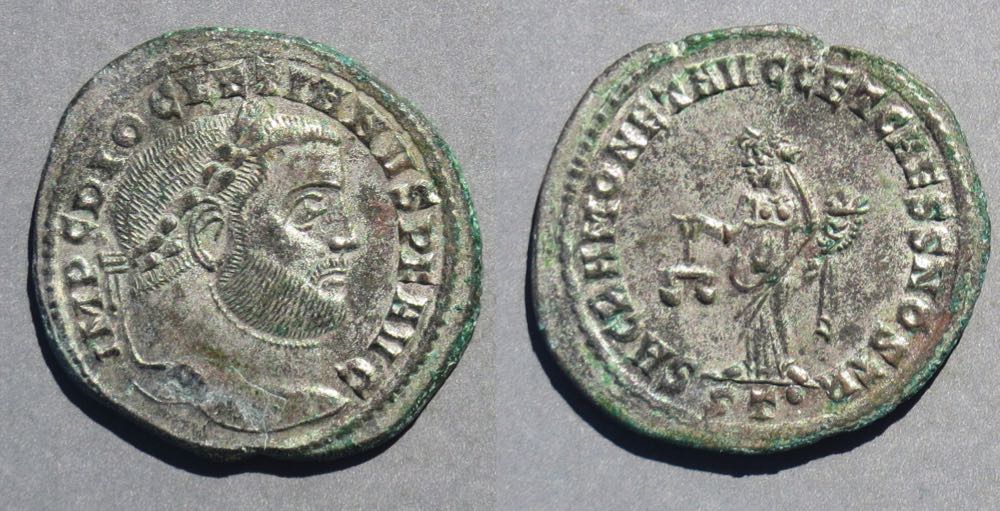 Diocletian
Diocletian
29-27 mm. 8.02 grams.
IMP C DIOCLETIANVS PF AVG
SACRA MONET AVGG ET CAESS NOSTR
ST•
RIC Ticinum 45a, "c. 300-303"
This example is surface-silvered. The next is the same issue, but with much different color.
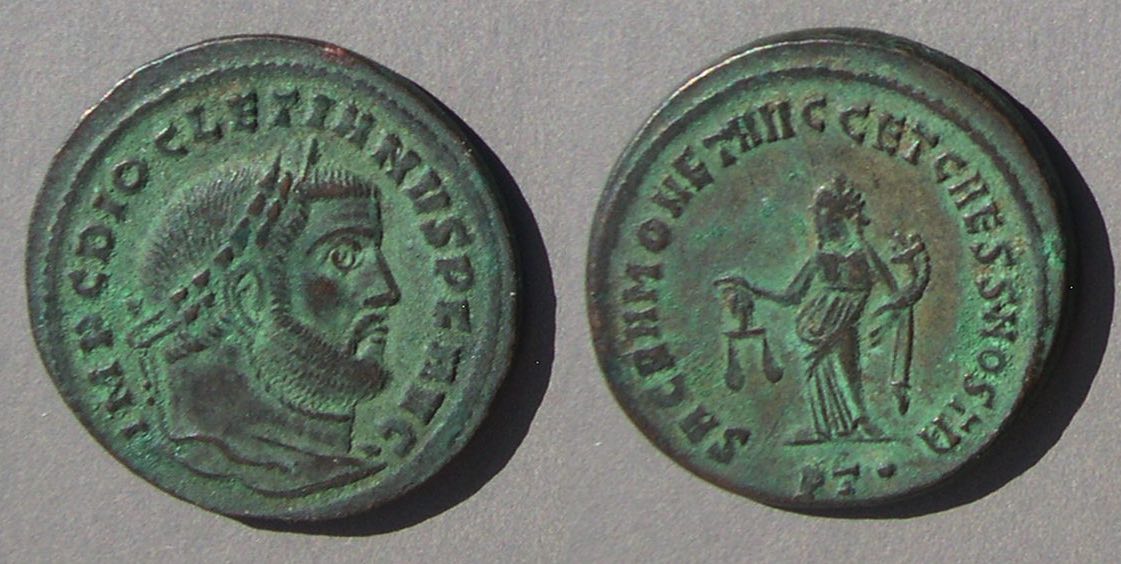
Diocletian
28 mm. 10.98 grams
IMP C DIOCLETIANVS PF AVG
SACRA MONET AVGG ET CAESS NOSTR
PT•
RIC Ticinum 45a "c. 300-303"
 Maximian
Maximian
25 mm. 9.86 grams.
IMP C MAXIMIANVS PF AVG
SACRA MONET AVGG ET CAESS NOSTR
ST•
RIC Ticinum 45b "c. 300-303"
 Constantius
Constantius
26 mm. 10.35 grams.
CONSTANTIVS NOB CAES
SACRA MONET AVGG ET CAESS NOSTR
ST•
RIC Ticinum 44a "c. 300-303"
Siscia. Coins of Siscia are very similar to those of Aquileia and Ticinum, but are a little less common.
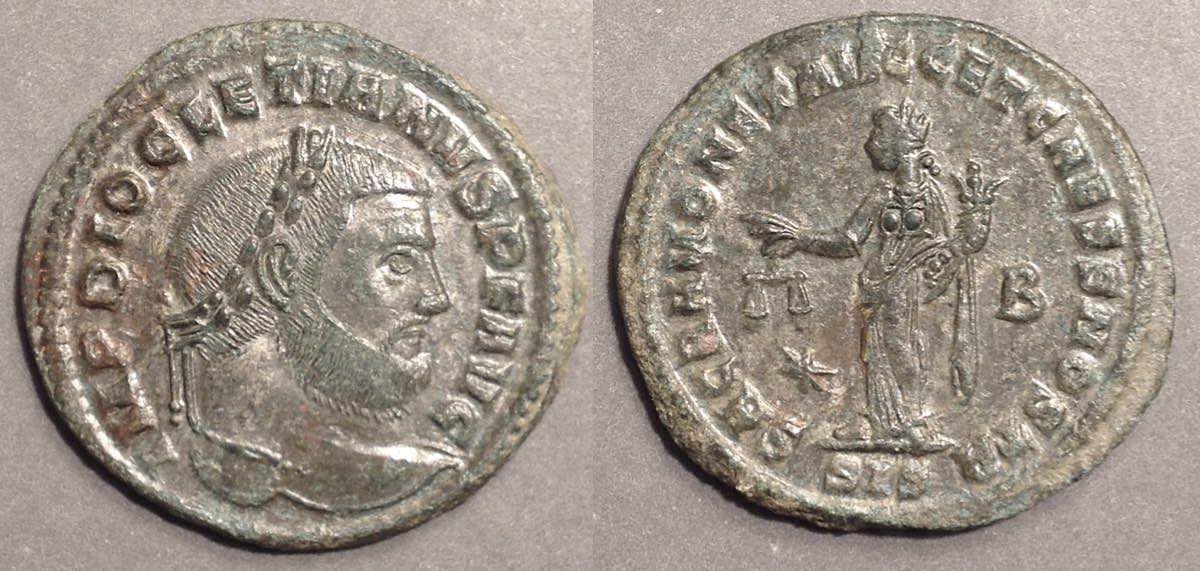 Diocletian
Diocletian
29-27 mm. 9.48 grams.
IMP DIOCLETIANVS PF AVG, laureate head right
SACRA MONET AVGG ET CAESS NOSTR
* B
SIS
RIC Siscia 134a "c. 301"
 Maximian
Maximian
28 mm. 8.91 grams.
IMP MAXIMIANVS PF AVG
SACRA MONET AVGG ET CAESS NOSTR
Γ
*SIS
RIC Siscia 131b
 Constantius
Constantius
28-27 mm. 9.57 grams.
CONSTANTIVS NOB CAES, laureate head right
SACRA MONET AVGG ET CAESS NOSTR
* B
SIS
RIC Siscia 135a "c. 301"

Galerius
28-26 mm. 9.57 grams.
MAXIMIANVS NOB CAES
SACRA MONET AVGG ET CAESS NOSTR
* Γ
*SIS
RIC Siscia 137b "c. 302"
Some coins of Siscia have the legend MONETA AVGG ET CAESS NN (omitting SACRA entirely. There are no examples here.).
Rome. The Rome mint inserted the word "VRB" and abbreviated "NOSTR" to "NN" (plural).
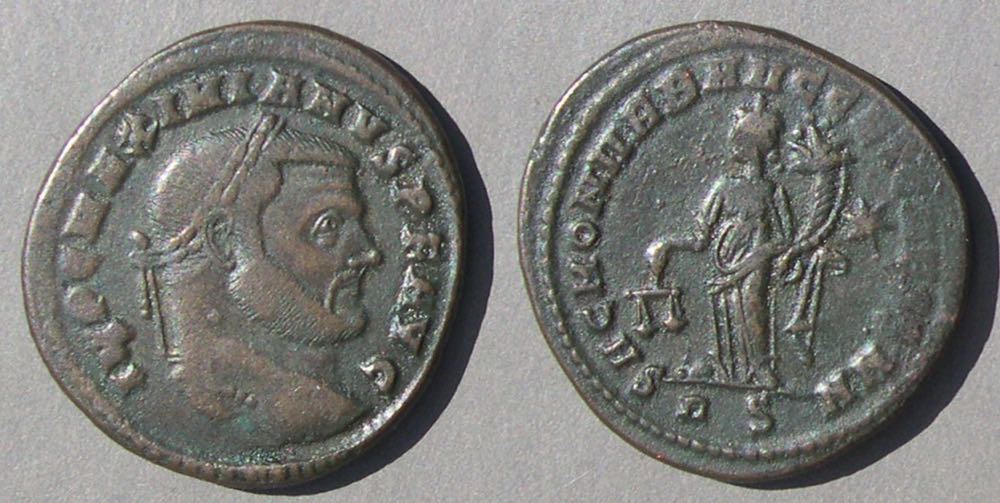
Maximian
29 mm. 12.13 grams.
IMP C MAXIMIANVS PF AVG
SAC MON VRB AVGG ET CAESS NN
*
RS in exergue
RIC Rome 105b "c. 302-3"

Constantius
27 mm. 9.55 grams.
CONSTANTIVS NOB CAES
SAC MON VRB AVGG ET CAESS NN
R<crescent upward>T
RIC Rome 112a "c. 303-5"
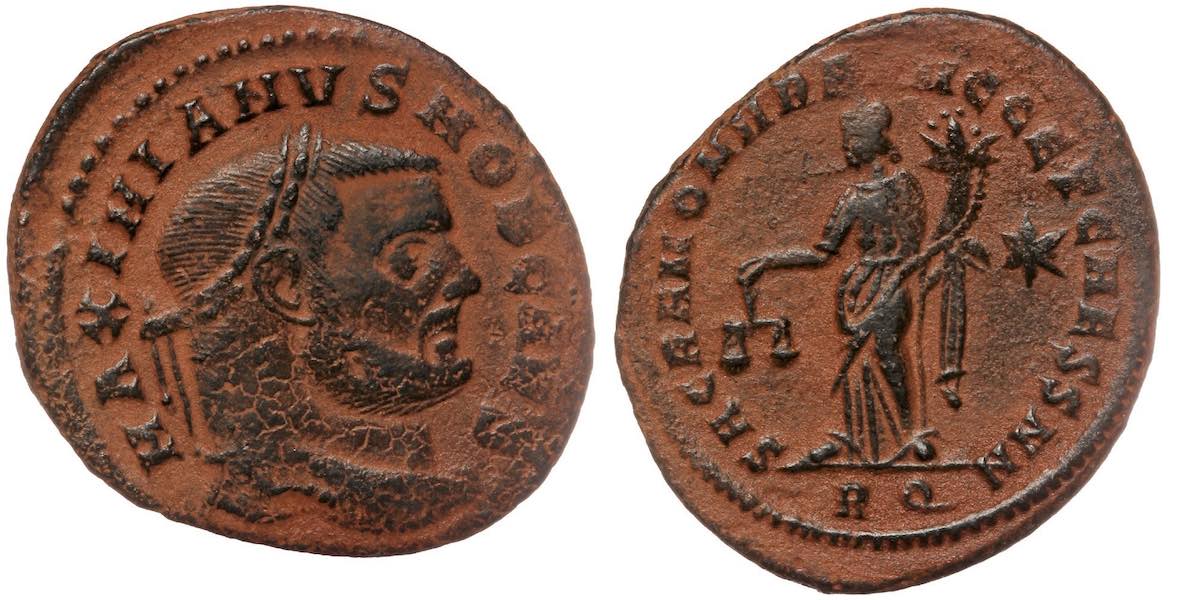 Galerius
Galerius
30-27 mm. 8.75 grams.
MAXIMIANVS NOB CAES
SACRA MON VRB AVGG ET CAESS NN
*
RQ
RIC VI Rome 104b, "c. 302-3"
Lovely orange and black surface
Trier. The other four mints begin the legend "SACRA MONET" (or some abbreviation of it), but Trier reverses the order of the first two words. Also, at Trier many have portrait busts laureate and in a cuirass, as opposed to just laureate heads typical from the other mints.
 Diocletian
Diocletian
27 mm. 8.39 grams.
IMP DIOCLETIANVS AVG
Laureate and cuirassed bust right.
MONETA S•AVGG ET CAESS NN
S F
ITR in exergue.
RIC Trier 549a "c. 302-3"

Maximian
28 mm. 9.30 grams.
IMP MAXIMIANVS PF AVG
MONETA•S•AVGG ET CAESS NN
S F
ITR in exergue
RIC Trier 544b "c. 302-3"
Constantius
31-28 mm. 9.27 grams. Large!
FL VAL CONSTANTIVS N C
MONETA•S AVGG ET CAESS NN
✳
ATR in exergue
RIC Trier 448 "c. 300-1"
 Galerius
Galerius
29 mm. 10.08 grams.
MAXIMIANVS NOB CAES
MONETA•S•AVG ET CAESS NN
*
BTR
RIC Trier 454b, "c. 300-1"
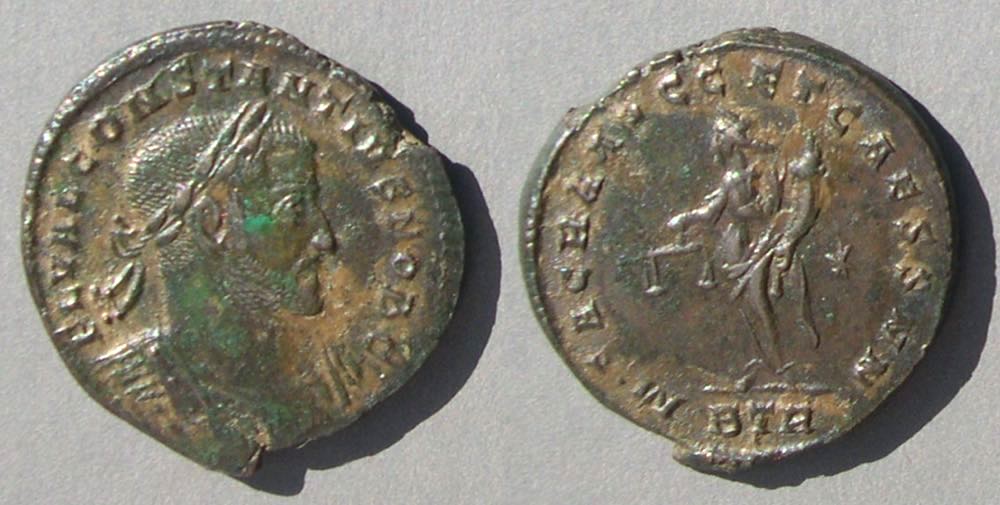 Constantius
Constantius
28 mm. 11.42 grams.
FL VAL CONSTANTIVS NOB C
laureate and cuirassed bust right
M•SACRA AVGG ET CAESS NN
*
BTR
RIC Trier 481a "c. 300-301"
The End
Go to the page, "Introduction to coins of the First Tetrarchy."
Go to the page of links to other pages on tetrarchal coins.
 SACRA MONETA: A common late Roman coin type
SACRA MONETA: A common late Roman coin type Diocletian
Diocletian Diocletian
Diocletian

 Galerius
Galerius Constantius
Constantius Diocletian
Diocletian
 Maximian
Maximian Constantius
Constantius Diocletian
Diocletian Maximian
Maximian



 Galerius
Galerius Diocletian
Diocletian

 Galerius
Galerius Constantius
Constantius